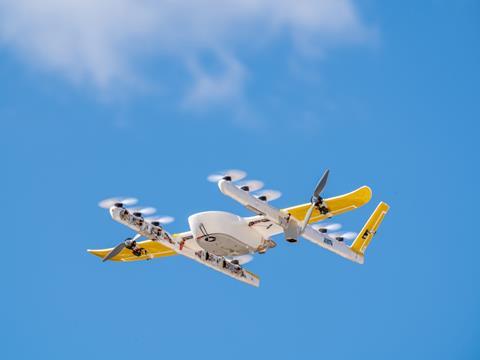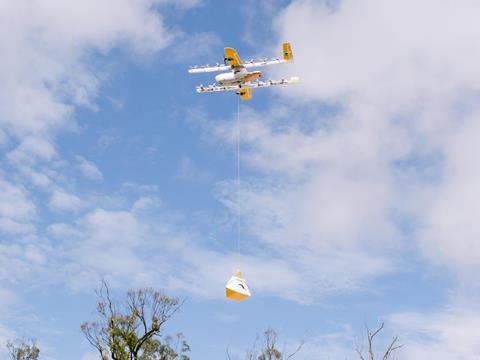
To many consumers, the idea of products being delivered by drones may seem fanciful. However, Wing, which is owned by Alphabet – Google’s parent company – is already operating its drone delivery services in three countries. We spoke with the company to learn more.
Broadly speaking, why should the packaging industry be interested in drone delivery technology? What are the potential benefits?
Several of the merchant partners we work with today have told us they previously gave up on home delivery altogether, because the finances just didn’t work out. Brugh Coffee, one of our merchants in Virginia, tried more typical on-demand delivery options previously, but he said it cost too much and drinks arrived too cold. But with drone delivery, suddenly home delivery is back on the table.
As this technology expands, we expect businesses to be able to deliver goods more safely, more efficiently, faster, and at a lower cost than conventional road transportation. Right now, last-mile delivery accounts for over 50% of the total cost to ship a good. In the next decade, the number of last-mile delivery vehicles on our roads is set to grow by 36%, increasing emissions by 30% and adding 11 minutes to the average commute, according to the World Economic Forum.
By leveraging the underutilized space above us, drone delivery can lessen our reliance on the ground beneath us, cutting costs and emissions, reducing congestion, and making our roads safer.
A recent study conducted by Virginia Tech University found that drone delivery at scale in an average U.S. metro area could save the average consumer up to 56 hours per year by reducing unnecessary errands and trips; generate up to $284,000 USD per year in new sales for a typical restaurant; reduce vehicle traffic by 294 million miles per year, equivalent to taking 25,565 cars off the road; avoid up to 568 car crashes per year; and displace up to 113,900 tons of CO2 per year, equivalent to planting 46,000 acres of new forest.
Our model also allows businesses to reach more customers. According to a study by Gaia Consulting in Finland, the use of drones in-home deliveries could expand the market reach of local businesses by 2x or 3x by 2030. The wider operating area could enable companies to reach 250,000 more households and would increase product variety for consumers by 3x to 8x.
Could you give us some details on how the process works, from when the customer orders a product to when the product is delivered to them?
Wing’s drones are custom-designed to deliver packages safely, reliably and very quickly. Once a customer submits an order, our drone picks up the package at our delivery facility. The drone then climbs to a cruise height on average of about 45 metres above ground, flying to the designated delivery destination typically in several minutes.
Once at the customer destination, the drone slows down, hovers, descends to a delivery height approximately seven metres above the ground, and then lowers the tether and automatically releases the package in the desired delivery area. There is no need to unclip or assist with the delivery of the package. Needless to say, the whole process is fully Covid-19 friendly, allowing customers, notably the most vulnerable ones, to shop safely from their homes.
In the past, safety concerns have been raised about the proliferation of drones in both commercial and recreational capacities. How would you respond to these concerns?
Safety is the number one priority at Wing. We have flown more than 100,000 flights to confirm the safety of our operations, and have had no safety incidents in the tens of thousands of deliveries made across three continents. We have multiple levels of redundancy built into our operations, including real-time systems that conduct health and safety checks on our drones and qualified pilots who oversee operations.
To enable us to offer our services, civil aviation authorities (CAA’s) in the US, Australia and Finland have all rigorously reviewed the safety of Wing’s aircraft, personnel and operations to ensure operations meet the highest level of safety.
Lightweight delivery drones are among the safest ways to transport goods; they are safer for the community than having goods delivered by truck or car or driving yourself to pick up an item from the store. According to the Queensland Government’s report in Australia, if drone deliveries replaced only 0.7% of motor vehicle journeys, this could result in 1100 fewer accidents on Queensland roads for instance.

Sustainability is perhaps the biggest issue in the packaging industry today. Would the increased use of drones in a delivery context bring sustainability benefits?
Wing prides itself on being a good steward of airspace and the environment. Small drone deliveries can produce 99% fewer emissions than pick-ups via car. In fact, it takes less energy to deliver a box of pasta via a Wing drone than it does to heat water to boil it. These energy savings are a result of the energy-efficient all-electric design of our delivery drones. When a delivery is made by Wing aircraft, it takes a car off the road that would otherwise make that trip. Overall, this means less traffic, fewer emissions, and safer roads.
A study by Gaia Consulting in Finland suggests that by 2030 drone delivery could lead to 11 million fewer vehicle delivery kilometres reducing congestion and overall emissions. The study goes on to posit that drones could reduce greenhouse gas emissions in Helsinki by 2,000t CO2 in 2030. This reduction in greenhouse gas emissions is equivalent to almost 350,000 electric sauna heating sessions or an estimated annual carbon sink of about 250 hectares of forest, which equates to approximately 350 football fields.
Wing’s solutions are currently being trialled in Finland. Could you give us some background on this trial and tell us about any lessons you have learned from it thus far?
Finns are internationally renowned for being early adopters of new technologies, and Wing has been working with local communities and businesses to find the best way to implement our services in the Helsinki area. Another reason why Helsinki made sense is their ambitious goals on cutting greenhouse gas emissions as well as decreasing the need for private cars in the city centre. We believe that our drones can make transport of goods more efficient and more sustainable and can partly replace transport by car.
Our early users in Finland told us they wanted greater product variety. In response to that, we have partnered with Alepa, Fazer and other merchants, and are introducing new meals, snacks and beverages.
We knew that the Finnish weather would be a challenge, and the strong winds, rain, ice and snow in its various forms lured us to Finland in the first place. We know that if we can fly in the heat of Australia, and in the cold of Finland, we can fly almost anywhere!
We started doing cold-weather tests in the Finnish city of Tampere in 2018, and during our winter breaks in 2019 and 2020, we continued this work with a series of tests in the north. Weather-proofing our drone is no easy feat. But, we have started flying a more weather-resistant model of our aircraft, so we can offer a more reliable service in a range of bad weather – from below zero conditions to rain.
Finland is also the first place where we began offering our service in public parks. Passers-by can spot a Wing sign, download our app, and order a picnic within minutes.
Looking ahead, when can we expect to see drone delivery become mainstream, and what barriers are in the way?
You are going to see much more collaborative and creative solutions! Through our collaborations, trials and test runs, we have shown how drones are creating a new era of accessible aviation that can bring incredible benefits when we need them most. Drone delivery has the potential to reduce inequalities in access to quality products, notably for the elderly, for people with disabilities or health issues and for those in more rural areas.
The transformation of air traffic management is firmly underway and over the past two years, Wing has been committed to global initiatives (research, technology development, and policy and advocacy) that demonstrate how the air traffic management ecosystem can evolve to support the volume and diversity of unmanned aviation.
Currently, drone delivery is confined to a number of communities that have received special permissions to pilot these services. We are grateful for the innovative spirit of these communities and the respective aviation regulators with whom we have worked to make drone delivery possible in the US, Australia and Finland. Industry and governments must work together to empower companies like Wing to scale beyond these trials to make commercial drone deliveries at global scale a reality.
















